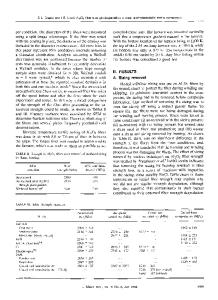Effect of magnesium on the aging behavior of Al-Zn-Mg-Cu/Al 2 O 3 metal matrix composites
- PDF / 1,715,809 Bytes
- 8 Pages / 598 x 778 pts Page_size
- 43 Downloads / 265 Views
I.
INTRODUCTION
ALUMINUM-based metal matrix composites (MMCs) have been developed and studied for many years. These materials usually combine the high Young's modulus and strength of a ceramic with the ductility of a metal. Some of the composites, such as those reinforced with either B4C, A1203, or SiC, are now commercially available in a variety of structural forms. Most of the alloys that have been employed as matrices in MMCs are A356,m 2 0 0 0 , t2,3,41 and 6000 [5,6,71 series. However, much less attention has been paid to the A1-Zn-Mg-Cu 7000 series alloys, which show the highest strength of all commercial aluminum alloys and are widely used for structural materials in military and civil aircrafts. The 7000 series, A1-Zn-Mg and A1-Zn-Mg-Cu type, aluminum alloys are strengthened by precipitation reactions accompanying heat treatment. Complicated aging behaviors in this system are reported by many workers.IS ~3] The precipitation process in a series of A1-Zn-Mg-Cu alloys deduced from X-ray, [81 electron microscope, [9,~~ and differential scanning calorimetry (DSC)EH.~2.~31 investigations is summarized as follows: Supersaturated solid solution Guinier-Preston (GP) zones r/' (MgZn2)
> > > ~/(MgZn2)
However, designing the composite microstructure and aging treatments, based directly upon the precipitation characteristics of the unreinforced matrix material, may result in impaired strengthening without fully using the potential of the composite material. It has been observed that aging kinetics are enhanced or retarded by the presence of reinforcement during heat treatment in different MMC materi-
MING-CHUN CHOU, Graduate Student, and CHUEN-GUANG CHAO, Associate Professor, are with the Institute of Materials Science and Engineering, National Chiao Tung University, Hsinchu, Taiwan #130049, Republic of China. Manuscript submitted October 18, 1994. METALLURGICAL AND MATERIALSTRANSACTIONS A
als. Nieh and Karlakt141 found the accelerated aging effect of B4C reinforcements on a 6061 aluminum alloy matrix. They suggested that the accelerated aging a primarily due to the high dislocation density generated from thermal mismatch between the BaC reinforcements and the aluminum matrix and the presence of high diffusive interfaces in the composites. Dutta and Bourell[l'l indicated that the accelerated aging effect can be attributed to an increased dislocation density in the immediate vicinity of the reinforcements or the residual stress field in the matrix surrounding the reinforcements. On the contrary, Ceresara and Fiorini reported that the suppression of the GP zone formation was observed in sintered aluminum powder type A1-Cu/A1203v6~ and A1-Mg-Cu/A1203.vT~ They suggested the fiber-matrix interface acts as a sink for vacancies during quenching. In addition, Bardhan and Starker81 reported that magnesium plays the role of a reversible vacancy trap in A1-Zn-Mg alloys. Higher magnesium content induces a greater extent of quench clustering, resulting in a large as-quenched hardness difference in alloys with only slightly di
Data Loading...











